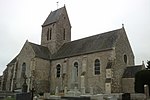Carentan Airfield
Airfields of the United States Army Air Forces in FranceAirports established in 1944World War II airfields in France

Carentan Airfield is an abandoned World War II military airfield, which is located near the commune of Carentan in the Normandy region of northern France. Located just outside Carentan, the United States Army Air Force established a temporary airfield 15 June 1944, nine days after the first Allied landings in France on D-Day and only three days after the capture of Carentan. The airfield was one of the first established in the liberated area of Normandy, being constructed by the IX Engineering Command, 826th Engineer Aviation Battalion.
Excerpt from the Wikipedia article Carentan Airfield (License: CC BY-SA 3.0, Authors, Images).Carentan Airfield
Rue de Banville, Saint-Lô
Geographical coordinates (GPS) Address Nearby Places Show on map
Geographical coordinates (GPS)
| Latitude | Longitude |
|---|---|
| N 49.305 ° | E -1.1794444444444 ° |
Address
Rue de Banville
Rue de Banville
50500 Saint-Lô
Normandy, France
Open on Google Maps











